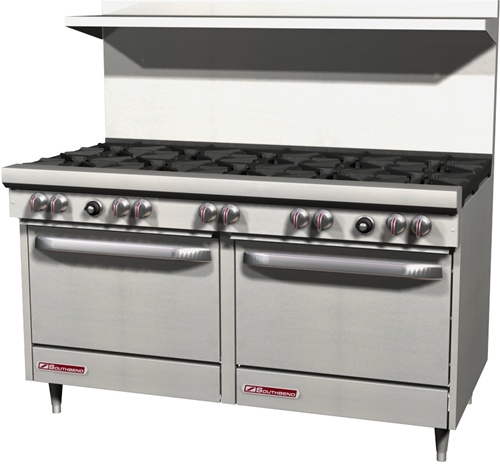
Stove range repair symptoms and fixes.

|
01
- Range/Stove/Oven
Igniter source.
The
igniter is the most commonly defective part for an oven not
heating. The igniter has two main functions. First, the
igniter draws electrical current through the oven safety valve
to open it. Second, the igniter gets hot enough to glow and
ignite the gas in the oven burner. If the igniter gets weak,
it will fail to open the safety valve correctly. If the valve
does not open, the oven will not heat. To determine if the
igniter is defective, observe the igniter when the oven is on.
If the igniter glows for
more than 90 seconds without igniting the gas flame, this
indicates that the igniter is too weak to open the valve. If
the igniter is weak, replace it. If the igniter does not glow
at all, use a multimeter to test the igniter for continuity.
If the igniter does not have continuity, replace it.
|
|
02
- Range/Stove/Oven Bake
Element
When
the bake element is heating properly, it glows red hot. If
the element does not glow red, this indicates that the
element is not heating. Often, if the heating element has
burned out, it will be visibly damaged. Inspect the heating
element for holes or blisters. To determine if the bake
element has burned out, use a multimeter to test the element
for continuity. If the bake element does not have
continuity, replace it.
|
|
03
- Range/Stove/Oven
Control Board
An
oven's control board will often be used to send voltage to
the bake and broil elements or the igniters. If the control
board is defective, the voltage may not be sent to these
components and the oven will not heat. You can inspect the
board for signs of damage or a shorted component. You can
also use a multimeter to test for voltage reaching the bake
or broil elements or igniters after reviewing the
appliance's wiring diagram.
|
|
04
- Range/Stove/Oven
Temperature Sensor
An
oven's temperature sensor monitors the temperature inside
the oven cavity in order to maintain an accurate
temperature. If the temperature sensor is faulty, the oven
may not heat at all. The sensor can be tested for a proper
ohm reading at a set temperature with a multimeter to help
determine if the part is defective or not.
|
|
05
- Range/Stove/Oven Bake
or Broil Spark Electrode
For
bake & broil burner ignition an oven burner spark
electrode is used to ignite the gas. The electrode is a device
that sits right next to the burner. It functions like a spark
plug. As power is applied to it a spark jumps from the spark
electrode tip to the to the electrode shield, igniting the
gas. If the electrode is broken or worn out the spark may not
occur. Visually inspect the electrode assembly for cracks in
the porcelain housing or damage to the electrode tip itself.
Be aware that a proper
ground and the correct polarity of the incoming voltage to the
range is necessary for the electrode control to sense the
presence of a flame once the burner is ignited. If the burner
goes off after ignition check for proper ground and the
correct polarity at the wall outlet.
|
|
06
- Range/Stove/Oven
Broil Element
Inspect
the broil element for holes or blisters. When the broil
element is heating properly, it glows red hot. If the
element does not glow red, this indicates that the element
is not heating. Often, if the broil element has burned out,
it will be visibly damaged. To determine if the broil
element has burned out, use a multi-meter to test the
element for continuity. If the broil element does not have
continuity, replace it.
|
|
07
- Range/Stove/Oven
Spark Module
For
gas ovens using a spark igniter, a faulty spark module could
be responsible for the oven not heating. If you do not see a
spark near the bake or broiler burner tube when the oven is
turned on, use a multimeter to determine if voltage is
reaching the spark module. If power is present, the spark
module is likely defective and will need to be replaced.
|
|
08
- Range/Stove/Oven
Thermal Fuse or incoming power issue.
If
the oven gets too hot, the thermal fuse trips to shut off
power to the oven. If the thermal fuse has blown, the oven
will not heat. However, this is not a common occurrence. To
determine if the thermal fuse is at fault, use a multi meter
to test the fuse for continuity. If the thermal fuse does
not have continuity, replace it. The thermal fuse cannot be
resetóif the fuse has blown, it must be replaced. If dead
maybe 220vac. If display lights but no heat can be one side
of AC line incoming L1 or L2.
|
|
09
- Range/Stove/Oven Oven
Control Board
The
oven control board has relays that send voltage to the bake
and broil circuits according to the user settings and sensor
input. If the control board is defective, it may not send
voltage to the heating components. However, this is rarely the
case. Before replacing the control board, first test all of
the heating components. If you determine that all of the
heating components are working properly, replace the oven
control board. Since itís not easy to test the oven control
board, you will have to
replace the control board if you suspect it is defective
|